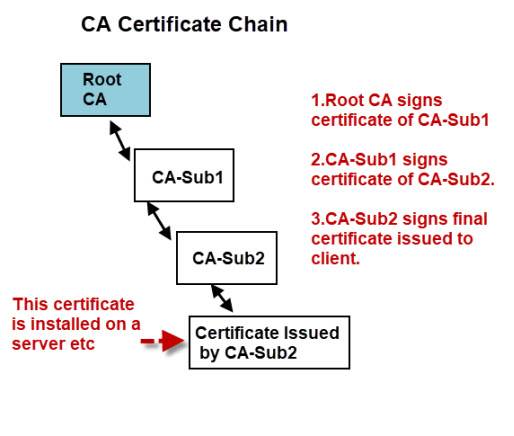

- Make a cert chain crt with simpleauthority password#
- Make a cert chain crt with simpleauthority download#
To ensure Browser recognise, open IE ->Tools->Internet Options -> Content -> Import the Root CA in Trusted Certification Authority Section and the Intermediate CA in Intermediate Certification Authority Section. openssl rsa -in serverPrivateKey.key -out serverPrivateKey.pem Step 4: Generate the intermediate CA key pair and certificate. Step 3: Generate the root CA key pair and certificate. In this example, we will use a TLS/SSL certificate for the client certificate, export its public key and then. Trusted client CA certificate is required to allow client authentication on Application Gateway. Step 2: Configure openssl.cnf for Root and Intermediate CA Certificate. An existing client certificate is required to generate the trusted client CA certificate chain.
Make a cert chain crt with simpleauthority password#
Note: Command to convert Server's Private Key in. OpenSSL encrypted data with salted password (Optional) Step 1: Create OpenSSL Root CA directory structure. SubjectAltName = alt_names ] DNS.1 = localhost Openssl x509 -req -sha256 -days 100 -in serverSignRequest.csr -CA intermediateCACertificate.crt -CAkey intermediateCAPrivateKey.key -CAcreateserial -extfile domain.ext -out serverCertificate.crtĬontents of domain.ext is provided below:īasicConstraints = CA:FALSE keyUsage = nonRepudiation, Openssl req -new -nodes -newkey rsa:2048 -keyout serverPrivateKey.key -out serverSignRequest.csrĬommand to Create Server's Certificate Signed by IntermediateCA KeyUsage = critical, digitalSignature, cRLSign, ke圜ertSignĬommand to Create Server's Private Key and Sign Request Openssl x509 -req -sha256 -days 100 -in intermediateCACertificateSignRequest.csr -CA rootCACertificate.pem -CAkey rootPrivateKey.key -CAcreateserial -extfile domain.ext -out intermediateCACertificate.crtĬontents of domain.ext is provided below: subjectKeyIdentifier = hashĪuthorityKeyIdentifier = keyid:always,issuer Openssl req -new -nodes -newkey rsa:2048 -keyout intermediateCAPrivateKey.key -out intermediateCACertificateSignRequest.csrĬommand to Create Intermediate CA's Certificate Signed by RootCA pem format openssl x509 -outform pem -in rootCACertificate.pem -out rootCACertificate.crtĬommand to Create Intermediate CA's Private Key and it's Certificate Sign Request Note: Command to convert RootCA Certificte from. Openssl req -new -nodes -newkey rsa:2048 -sha256 -days 100 -keyout rootPrivateKey.key -x509 -out rootCACertificate.pem
Make a cert chain crt with simpleauthority download#
Log into your DigiCert Management Console and download your Intermediate (DigiCertCA.crt), Root (TrustedRoot.crt), and Primary Certificates (yourdomainname.crt). pem with the Private Key and Entire Trust ChainBelow Commands 1-5 helps in creating the Certificate ChainĬommand to Create RootCA's Private Key and Self Signed Certificate I found the answer in this article: Certificate B (chain A -> B) can be created with these two commands and this approach seems to be working well.: Create a certificate request openssl req -new -keyout B.key -out B.request -days 365 Create and sign the certificate openssl ca -policy policyanything -keyfile A.key -cert A.pem -out B.pem. pem with the Entire SSL Certificate Trust Chain.

Log into your DigiCert Management Console and download your Intermediate (DigiCertCA.crt) and Primary Certificates (your_domain_name.crt).Ĭreating a. CRT has important implications for leader selection and for situational. pem with the Server and Intermediate Certificates The research reference on You Make the Ethical Call 1, Leadership Gender. Save the combined file as your_domain_name.pem. (Your Intermediate certificate: DigiCertCA.crt) This you have to import to your client computer, that is for each client computer you wish to access the web server using client certificate. (Your Primary SSL certificate: your_domain_name.crt) For each certificate starting with the one above root: 2.1 Concatenate all the previous certificates and the root certificate to one temporary file (This example is for when you are checking the third certifate from the bottom, having already checked cert1.pem and cert2. Make sure to include the beginning and end tags on each certificate. Split the chain file into one file per certificate, noting the order. The Intermediate Certificate - DigiCertCA.crt The Primary Certificate - your_domain_name.crt Open a text editor (such as wordpad) and paste the entire body of each certificate into one text file in the following order: Log into your DigiCert Management Console and download your Intermediate (DigiCertCA.crt), Root (TrustedRoot.crt), and Primary Certificates (your_domain_name.crt). pem with the Entire SSL Certificate Trust Chain This article contains multiple sets of instructions that walk through various. pem files (concatenated certificate container files), are frequently required for certificate installations when multiple certificates are being imported as one file.


 0 kommentar(er)
0 kommentar(er)
